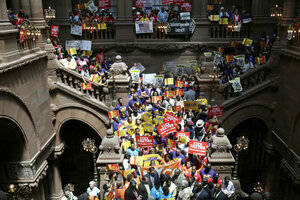With 21 states raising minimum wage, 2015 is a tipping point
As many as 7 million low-wage workers will see a pay increase, many on Jan 1. Minimum wages around the country will range from the federal minimum wage of $7.25 an hour to $9.47 an hour in Washington State.

People rally for an increase in the minimum wage on the Great Western Staircase at the Capitol in Albany, N.Y., June 17. In 2015, 21 states, including New York, will increase the minimum wage.
Mike Groll/AP
Washington
Workers in 21 states will see the minimum wage rise in 2015, which means that, for the first time, more than half of US states will be above the federal minimum.
The wage hikes are a sign of growing momentum for nationwide efforts backed by labor unions to help the economy’s bottom-rung workers. The moves also represent an expanding set of experiments in what happens to the job market when minimum pay is set at various levels.
Base-level wages will range in 2015 from the federal minimum of $7.25 an hour to $9.47 an hour in Washington State. (In certain cities, it could be higher: Seattle and San Francisco passed increases that will eventually climb to $15 an hour, while Chicago workers will see their minimum wage rise to $13 an hour by 2019.)
The White House estimates that 7 million workers will see their pay rise due to minimum wage changes enacted since 2013. But the wisdom of the policies is still a matter of debate among economists, with some warning that too big a boost could put a damper on job growth that outweighs the benefits of rising pay for low-income workers.
Here’s where the minimum is changing in the new year:
For the first time, Arkansas, Hawaii, Maryland, Nebraska, South Dakota, and West Virginia will have minimum wages above the federal level, which has been unchanged for more than five years.
Beyond those six states, another six that already had higher-than-federal minimums have decided on a boost: Alaska, Connecticut, Massachusetts, New York, Rhode Island, and Vermont. The District of Columbia will also see a rise in 2015.
And in nine states, the minimum wage will rise due to automatic adjustments to keep wages in line with inflation. Those states are Arizona, Colorado, Florida, Missouri, Montana, New Jersey, Ohio, Oregon, and Washington.
The changes take effect Jan. 1, except for Alaska (in late February) and D.C. (mid-year), according to tracking by the National Conference of State Legislatures.
Altogether, 29 states, plus the nation’s capital, will have minimum wage rates above the federal level, the Labor Department says.
Some state moves arose from ballot initiatives; others, within the state legislature.
A key goal of labor unions and other backers of the changes: seeking to ensure that holding a job equals a “living wage.”
As living costs have risen, in areas ranging from food and shelter to health care and education, pay has stagnated for many US workers in recent years.
President Obama has called for a boost in the federal minimum wage to $10.10 an hour, but a Republican-controlled House of Representatives has resisted the proposal.
States that set their minimum pay levels at or below the federal rate lie heavily in the South, from Virginia to Texas, as well as some in the Great Plains (Kansas, North Dakota), and Mountain West (Idaho, Utah).
Americans who work at or below the federal minimum are disproportionately young (half are 24 or younger), and almost two-thirds work part time, according Labor Department data tracked by the Pew Research Center.
Last year, 1.5 million hourly workers earned the federal minimum of $7.25 an hour, and about 1.8 million others earned even less (legally, that can happen for tipped employees, full-time students, and certain disabled workers.)
Many economists support the idea of modest hike in minimum pay, arguing that the benefits for low-paid workers will outweigh any costs in slower job creation.

